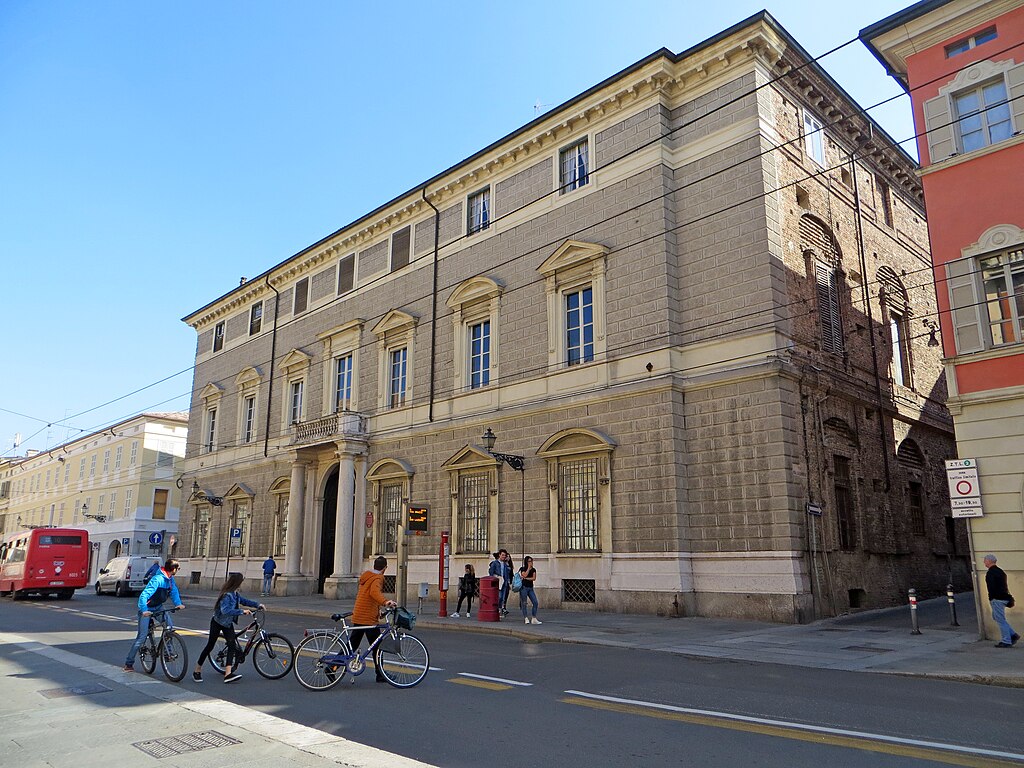
Palazzo Marchi – Image from Wikipedia
Nestled in the heart of Parma, Palazzo Marchi stands as a testament to the city’s rich cultural and artistic heritage. Built between 1770 and 1774 by Marquis Scipione Grillo, this 18th-century palace is a magnificent example of neoclassical architecture. Its elegant facade, stucco decorations, and rich artistic collection make it a must-visit for anyone interested in exploring Parma’s historical landmarks. Beyond its architecture, the palace houses important art collections that connect visitors to Parma’s cultural legacy, while its surroundings offer a deeper dive into the city’s history, from its Roman roots to Renaissance and Baroque influences.
The History of Palazzo Marchi
Palazzo Marchi was designed by Giovanni Isidoro Furlani, a pupil of the celebrated architect Ennemond Alexandre Petitot. The palace’s construction was commissioned by Marquis Scipione Grillo, Duke of Monterotondo, who played a significant role at the court of Parma. The building’s original purpose was to reflect the grandeur and refinement of the period, with a focus on intricate stucco work and elegant architectural lines.
After Grillo’s departure from the ducal court, the palace passed through several aristocratic families, including the Langosco-Alari, Malaspina, Galatino, and Mazza-Poldi families. Eventually, in 1859, Antonio Marchi, a well-known industrialist and patron of the arts, purchased the palace, and it has remained in his family ever since(Palazzo Marchi)(FinArt Online).
Today, the palace is part of the Castelli del Ducato circuit, a prestigious network of castles and historic residences in the region. This affiliation underscores its importance as a cultural site in Parma and allows visitors to explore its historical and artistic treasures through guided tours(FinArt Online).
The Artistic Legacy of Palazzo Marchi
Palazzo Marchi’s museum itinerary offers a journey through Parma’s artistic and cultural development during the 18th century. The palace houses an impressive collection of works owned by the Marchi family, ranging from paintings and sculptures to furniture and tableware. The collection serves as a vivid reminder of the city’s historical connection to the Academy of Fine Arts of Parma, which flourished under the guidance of notable figures such as Petitot(Palazzo Marchi).
One of the most prized pieces in the palace’s collection is Parmigianino’s San Rocco nel Paesaggio (Saint Roch in the Landscape), added in 2023. Parmigianino, a leading figure of the Mannerist movement, painted this masterpiece in the early 16th century. The painting, a fragment of a larger composition, portrays Saint Roch, the patron saint of those suffering from plagues, in a serene yet dramatic setting. The delicate brushwork and elongated forms characteristic of Parmigianino’s style make this painting a focal point for art enthusiasts(ilParmense)(Wikipedia, l’enciclopedia libera).
The inclusion of San Rocco nel Paesaggio at Palazzo Marchi adds another layer of cultural significance to the palace, linking Renaissance artistry with the 18th-century academic pursuits that defined Parma’s intellectual and artistic growth. The dialogue between these eras is further enhanced by the palace’s incorporation of contemporary art exhibitions, creating a fusion of historical and modern interpretations within its walls(ilParmense).
Exploring Palazzo Marchi
Visitors to Palazzo Marchi can embark on guided tours that offer insights into the palace’s history, architecture, and artistic treasures. The tours, organized by ArcheoVea Impresa Culturale, are available on weekends from March to July and from September to December, with the option of special appointments during other months(FinArt Online). Each tour takes visitors through the beautifully adorned rooms, including the piano nobile, where original 18th-century stucco work by Giocondo Albertolli still graces the walls and ceilings(Palazzo Marchi).
The palace’s location on Strada della Repubblica places it at the heart of Parma’s historic district, making it an ideal starting point for exploring other landmarks in the city. Whether you’re an art lover or a history enthusiast, Palazzo Marchi offers a unique window into Parma’s rich cultural tapestry.
Discovering Parma Beyond Palazzo Marchi
While Palazzo Marchi is a gem in its own right, its surroundings are equally captivating. Parma is home to a wealth of historical and artistic landmarks that complement a visit to the palace.
- Piazza Garibaldi – Just a short walk from Palazzo Marchi, Piazza Garibaldi is the bustling heart of the city, built over the site of an ancient Roman forum. The square is surrounded by notable buildings, including the 17th-century Palazzo del Governatore, with its distinctive astronomical clock(Nomads Travel Guide)(loveexploring.com).
- Cattedrale di Parma (Parma Cathedral) – Located nearby in Piazza Duomo, the cathedral is a stunning example of Romanesque architecture. Its interior is adorned with frescoes, including Correggio’s masterpiece, The Assumption of the Virgin, which decorates the dome and is considered one of the most important works of illusionistic ceiling painting(Nomads Travel Guide).
- Baptistery of Parma – Adjacent to the cathedral, the Baptistery is an architectural marvel, blending Romanesque and Gothic styles. Crafted from pink Verona marble, its interior features sculptures and frescoes by Benedetto Antelami, depicting zodiac signs and agricultural scenes(Nomads Travel Guide).
- Parco Ducale – For a peaceful retreat, the Parco Ducale offers a lush green space perfect for a leisurely stroll or picnic. This large park is located near Palazzo Ducale, another historical site that showcases the grandeur of Parma’s ducal past(Savoring Italy).
- Strada Farini – If you’re in the mood for shopping or dining, Strada Farini is a vibrant street filled with boutiques, artisan shops, and local eateries. It’s a great spot to explore Parma’s culinary delights, including the famous Parmigiano Reggiano and Prosciutto di Parma(loveexploring.com)(Savoring Italy).
Conclusion
Palazzo Marchi offers a captivating glimpse into Parma’s 18th-century aristocratic life, blending historical architecture, fine art, and cultural heritage. Whether you’re exploring the stunning neoclassical interiors or marveling at Parmigianino’s San Rocco nel Paesaggio, a visit to Palazzo Marchi is an enriching experience for anyone interested in Italy’s artistic legacy. Combined with the nearby landmarks of Piazza Garibaldi, Parma Cathedral, and the Baptistery, your journey through Parma promises to be a memorable one.
Emilia Deliziaをもっと見る
購読すると最新の投稿がメールで送信されます。